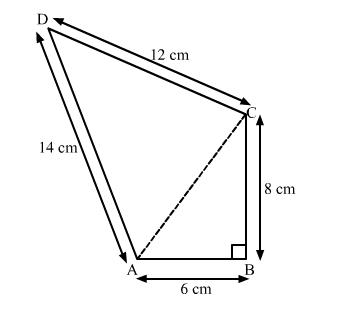The sides of a quadrilateral $A B C D$ taken in order are $6 \mathrm{~cm}, 8 \mathrm{~cm}, 12 \mathrm{~cm}$ and $14 \mathrm{~cm}$ respectively and the angle between the first two sides is a right angle. Find its area. (Given, $\sqrt{6}=2.45$ ).
In the given figure, ABCD is a quadrilateral with sides of length 6 cm, 8 cm, 12 cm and 14 cm respectively and the angle between the first two sides is a right angle.

Join AC.
In right angled ∆ABC,
$A C^{2}=A B^{2}+B C^{2}$ (Pythagoras Theorem)
$\Rightarrow A C^{2}=6^{2}+8^{2}$
$\Rightarrow A C^{2}=36+64$
$\Rightarrow A C^{2}=100$
⇒ AC = 10 cm
Area of $\triangle A B C=\frac{1}{2} \times A B \times B C$
$=\frac{1}{2} \times 6 \times 8$
$=24 \mathrm{~cm}^{2}$ ....(1)
In ∆ACD,
The sides of the triangle are of length 10 cm, 12 cm and 14 cm.
∴ Semi-perimeter of the triangle is
$s=\frac{10+12+14}{2}=\frac{36}{2}=18 \mathrm{~cm}$
∴ By Heron's formula,
Area of $\Delta A C D=\sqrt{s(s-a)(s-b)(s-c)}$
$=\sqrt{18(18-10)(18-12)(18-14)}$
$=\sqrt{18(8)(6)(4)}$
$=24 \sqrt{6} \mathrm{~cm}^{2}$
$=24(2.45) \mathrm{cm}^{2}$
$=58.8 \mathrm{~cm}^{2}$ $\ldots(2)$
Thus,
Area of quadrilateral ABCD = Area of ∆ABC + Area of ∆ACD
$=(24+58.8) \mathrm{cm}^{2}$
$=82.8 \mathrm{~cm}^{2}$
Hence, the area of quadrilateral $A B C D$ is $82.8 \mathrm{~cm}^{2}$.
